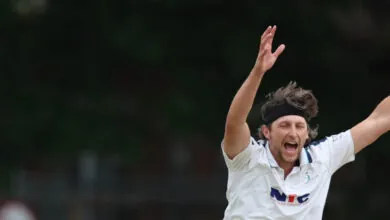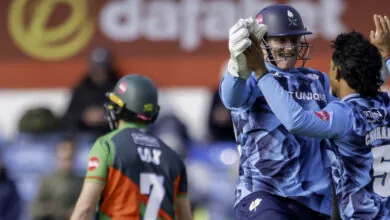David Frith surveys the service and the sacrifice from the world of cricket.
As part of Cricket Remembers, a campaign to remember the cricketers who so bravely fought in the Great War, esteemed cricket historian David Frith, the founder editor of Wisden Cricket Monthly and author of more than 30 books on cricket, below surveys the service and sacrifice from the world of cricket in the First World War and remembers some of the most poignant stories of cricketers involved in the war.
The cataclysmic conflict of 1914 to1918 was referred to as the Great War, and subsequently as the First World War after something just as horrendous was inflicted on mankind between 1939 and 1945. The ’14-18 war was defined by the seemingly interminable, blood-soaked stalemate on the killing-fields of France and Belgium as patriotic fervour and optimism gave way to impatience, exhaustion and despair as the months dragged on. The human cost was beyond realistic description. Grief touched most households across the United Kingdom and in the homelands of her allies. Countless wives and mothers waited in dread for the telegram boy knocking on the door and conveying the worst possible news.
Cricketers, of course, were at the forefront of the war effort, their huge contribution encouraged by the illustrious Dr W.G.Grace’s call to arms. Had he been younger, cricket’s mighty figurehead would surely have been among the first to don uniform. As it was, he shook his fist at the sinister clouds above south London which hid a lethal, groaning Zeppelin airship. “Now then, old boy,” said his friend Archie MacLaren, also a former captain of England, “you mustn’t get upset. Why, didn’t you face Ernie Jones [the bouncer-happy Australian fast bowler of the 1890s]?” “That’s as may be,” groaned WG, “but I could see him!” Days later, WG was dead following a stroke.
Numerous county cricketers served in the ’14-18 war. Some were killed, Test cricketers among them. Those who returned home had been changed irreparably, mentally if not physically. And if they resumed playing the game with greater freedom, it was because of their intense relief at having a peaceful normal life restored. Few cricketers of the modern era fortunately have ever experienced real warfare, with all its brutality, horror, hopelessness, and despair.
In the August 8, 1914 edition of the now-rare magazine The World of Cricket editor Archie MacLaren opened his editorial with the same sort of patriotic words employed by most publications at the time:
Armageddon may well be at hand. As one writes the talk is all of War-War-War! Cricket is naturally pushed into the background – naturally and rightly – big a part as the greatest of games plays in our national life. Yet when the thrilling call – “Who is on our side?” – goes forth, the debt the nation owes to cricket ought not to be forgotten. In spite of occasional squabbles – Sydney barracking, Bloemfontein incidents, and the like – cricket has perhaps done more than anything else to weld together.
Those who kneel beside us/ At altars not Thine own – as Kipling has it in his noble “Hymn Before Action”. And among the bonds that bind them will be the bond of cricket.
Stirring stuff typical of Archie MacLaren, who had scored 424 for Lancashire against Somerset twenty years previously, as well as five Test hundreds against Australia. This and much similar editorial material was consumed around the nation at that fearful time. Cricketers from village greens to county clubs, some only just out of school, volunteered to go to war during that tense autumn of 1914. The cricket season had only just been somehow completed midst the disruption. The Oval was requisitioned by the Army, so Surrey’s match against Kent (Jack Hobbs’s benefit match), followed by one against Yorkshire, were both played at Lord’s. The Surrey committee then decided to cancel the last two fixtures of the season, against Sussex at Hove and Leicestershire at The Oval. There was a pointed reference to remarks uttered by Lord Roberts in a recruiting speech regarding “people who went on playing cricket at such a time”. Ominously, gloomily, understandably, Britain’s Foreign Secretary Sir Edward Grey stated that “the lamps are going out all over Europe; we shall not see them lit again in our lifetime.”
In the following (and final) edition of his magazine, MacLaren featured two Men of the Season on the front cover. One was Percy Jeeves of Warwickshire. He seemed to be a certainty to be capped by England in the near future: but he was one of those destined not to survive the war.
MacLaren’s “Pavilion Gossip” was confident, but a little more serious than ever before: “The days of waiting are past. Great Britain is at war, and the people are glad thereof – glad with no riotous gladness, with no cocksure assurance, but soberly, sternly glad. It is not that we wanted war; but we could not brook dishonour. We had to stand by our friends, and to bear England’s old, great part – that of the nation towards which the little peoples looked as a shield and buckler against the arrogant tyranny of the continental despots.” Stirring words from “Archie Mac”.
Only as recently as 2014 has there been compiled a large and detailed listing of first-class players – amateur and professional – and also eminent school and club cricketers who lost their lives during the First World War. This epic work – Wisden on the Great War: the Lives of Cricket’s Fallen 1914-1918 (Bloomsbury, 2014) – was researched and written by Andrew Renshaw, a journalist, former editor of local newspapers, and a vice-president of Hampshire County Cricket Club. Circumstances prevented Mr Renshaw from contributing to this precis of his extraordinary book, but he has graciously supported this work, which has been developed on behalf of the England and Wales Cricket Board. Another major information source has been the even bulkier Who’s Who of Cricketers, the sumptuous 1993 creation of Philip Bailey, the late Philip Thorn, and Peter Wynne-Thomas.
Beyond county cricket, it is sobering to reflect that for every first-class cricketer who lost his life in the “Great War”, the roll-call of “ordinary” cricketers killed while fighting for their country remains incalculable. Club cricketers, apprentices and college boys innumerable died for the cause, some of them still in their teens. Their symbol might be Arthur Collins, who as a 13-year-old Clifton College schoolboy had scored 628 not out in a house match in 1899, for over a century the highest score made in a properly organised cricket match. He became a career soldier, a 2nd Lieutenant in the Royal Engineers, and was killed during the first Battle of Ypres. The date was November 11, 1914, and had the world but known it, this dreadful war had still to drag on for precisely four more years. The young cricket record-holder’s name is to be found on the Menin Gate Memorial in Belgium, as are the names of a multitude of other servicemen whose remains were not recovered.
Young British men, and some not so young, crossed the Channel on their way to war, patriotic, indignant and angry at German aggression and barbaric cruelty; and a little frightened too, for they were only human, and very young, many of them, with vivid imaginations. And some were cricketers, good players, some of them county players, and a handful of them had played for their country. Of those who came home, some like Harry Lee carried injuries for life, though they resumed playing the game they loved. Some, like Andy Sandham (who in 1929-30 became the first to score a Test triple-century), were removed from the firing line by injury. One – Percy Jeeves, who was killed in France – was even immortalised beyond the pages of Wisden when P.G.Wodehouse adopted the surname for his classic manservant of fiction.
The cricket that they played is barely recognisable today. Their white/cream attire had no commercial logos; their bats were lightweight; batting gloves were flimsy; caps, sunhats and sometimes trilby hats were worn, though many preferred to be bare-headed, whether the bowling was fast or slow; spectators sat on the grass by the boundary, and some grounds had dangerous spiked railings around the perimeter; the scores were available only in the evening or next morning’s penny or tupp’ny newspapers.
As we commemorate the centenary of the end of that most horrifying conflict, it is also time to acknowledge the incalculable contribution of cricketers from the length and breadth of the British Isles and beyond. It was indeed The Greater Game.
David Frith was editor of The Cricketer from 1972 to 1978 and founder-editor of Wisden Cricket Monthly 1979-96. He has written over 30 cricket books. Four of his ancestors served in the First World War; two never returned.




